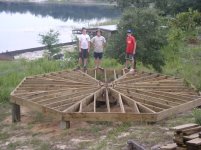You already have your posts in the ground, so I guess that's that unless you choose to add more. If it's not too late, you could probably get old cut off telephone poles for free from your local utility. I got several nice twelve-inch diameter ones to use for my gazebo (see attached photo). The poles are 4 1/2 to 5 feet down in the ground. The longest pole is about nine feet long total. They were heavy and hard to deal with, but a whole lot cheaper and better than anything else I could think of.
I used a $9 laser level from the truckload tool sale to mark the posts for cutoff. The trick was to calibrate the level first (using a good 4' level), then plumb the tripod I had the level on. After a while (and with double-checking with string, a long straight 2X4, and the good level) I gained confidence that I had everything set up correctly.
By slowly rotating the laser level I could mark a pencil line halfway around each pole. Then I used a long piece of paper with a straight cut on it to wrap around each post. When the edge of the paper lined up with itself and the pencil mark, the paper was level. I continued the pencil mark all the way around the post.
By the way, my BIL stopped by with his super laser level setup. His was no more accurate than my homebrew one since I had taken the time to calibrate it and double check everything before I marked the poles. You don't need the $200 one if you take your time and work with what you have. The water level is a good choice too.
In my case, I used a small chainsaw to cut the posts and got well under 1/8" of error, but for 6X6 I would just use a good circular saw. Go slowly and watch the line. Also, cut the posts off a few inches above the finish cut so the extra weight of the post does not bear down on the finish cut and pinch the blade.
After we put the frame on the posts I went over the whole thing with a straightedge and a power planer to level each joist relative to its neighbors. I had to do it anyway because of the differences in the widths of the wood, and it also meant that my 1/8" tolerance on the post cuts was plenty good enough.
You can also use the power planer to dress the top of the posts if you want to. It works OK on and end cut like that if you just watch the feed rate.
As always, practice cutting on scrap first.
Good Luck!
- Just Gary

